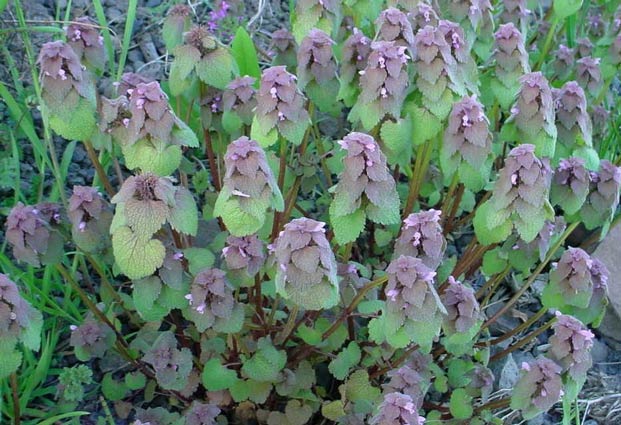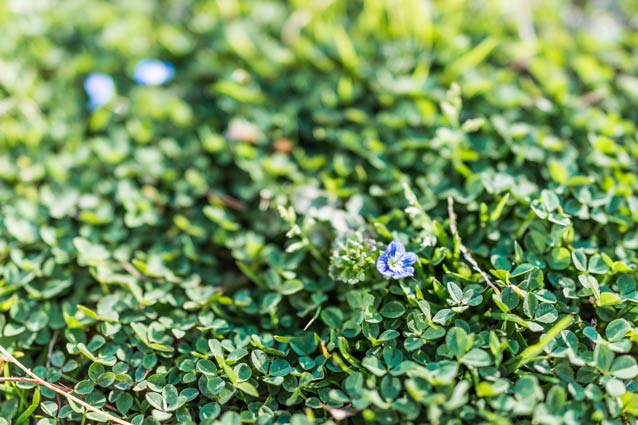How it Works: Preen Garden Weed Preventers
Here's how our Garden Weed Preventers prevent weeds before they even sprout rather than killing them after they’ve already had the chance to grow.
5 common winter annual weeds and how to control them
They’re there, whether you’ve seen them or not. Under the snow or leaves or maybe just beginning to poke through bare soil you might find pesky winter annual weeds.
Five of the most common – chickweed, hairy bittercress, henbit, speedwells, and purple deadnettle – emerge in late winter and early spring from seeds they sowed in late summer and fall. These weeds usually are found in flowerbeds, vegetable gardens, around trees and shrubs, in farm fields and sometimes, the lawn.
There are two kinds of chickweed: common chickweed (Stellaria media), a winter annual weed, and mouse-ear chickweed (Cerastium fontanum), which is a perennial weed. An annual weed returns from seed while a perennial weed grows from its roots.
Common chickweed quickly develops a mat in the lawn or in garden beds. It’s only about 1 inch tall, so lawnmowers usually miss it. Common chickweed has small, elliptical leaves, less than the size of a pinky fingernail. During the growing season, it displays dainty white flowers. These produce tiny seeds that winter over and germinate in cool, damp weather the following season.
A main difference between common chickweed and mouse-ear chickweed is revealed in the leaves. Mouse-ear chickweed’s leaves are covered with tiny hairs.
Learn more about common chickweed.

Common chickweed has small, elliptical leaves and dainty white flowers.
Hairy bittercress (Cardamine hirsuta) appears in late winter to early spring as three- to four-inch-tall clumps or “rosettes” with stems that have small, rounded, green leaves. The leaves are arranged alternately up the stems. Wiry stalks poke up six to eight inches above the clumps, forming dainty white, four-petalled flowers at the tips which mature into long, narrow, purplish seed pods that contain the weed’s seeds. The seeds shoot up to several feet away when touched or blown by a breeze.
Learn more about hairy bittercress.

The dainty flowers of hairy bittercress mature into long, narrow seed pods that contain the weed’s seeds.
Henbit (Lamium amplexicaule) is another member of the mint family and is related to dead nettle. Henbit has rounded, scalloped leaves. The leaves grow tightly along the square stems. The flowers are pinkish-purple. It has shallow roots which should be easy to pull.

Henbit has shallow roots that are easy to pull to stop it from spreading. . iStock / Getty Images Plus
Purple dead nettle (Lamium purpureum) has triangle-shaped, bumpy, slightly scalloped-edged leaves and a spike of blue flowers. A member of the mint family, dead nettle has square stems. It is easily recognizable by its leaves’ purplish hue. This weed can be thick in farm fields in spring. The color and leaves are a giveaway in the garden, too.

A member of the mint family, dead nettle has square stems. © Richard Old xidservices.com
Corn speedwell (Veronica arvensis) is another winter annual weed with blue flowers. It has triangular shaped leaves. Light blue flowers appear along the stems. Generally a lawn weed, but it also appears in gardens.

Corn speedwell has pretty little light blue flowers with triangular shaped leaves on long stems. © Getty Images
The first line of defense against weeds is to never let them go to seed. These winter annual weeds, which germinate in fall, are easy to pull by hand in late winter and early spring when they are actively growing. Try not to allow them to bloom and form seeds since that is how they spread. Even better, get a jump on these weeds by applying a pre-emergent weed preventer, such as Preen, that prevents weed seeds from germinating. Apply Preen in spring and again in late summer or early fall before weed seeds have germinated. Preen Weed Preventers stop these winter annuals and dozens of other weeds from germinating in flowerbeds and around trees and shrubs for three months or more.
Preen Extended Control Weed Preventer prevents more than 125 weeds for up to 6 months around 600 perennials, groundcovers, trees, and shrubs.
Preen Garden Weed Preventer prevents weeds for up to 3 months in flower & vegetable gardens and around groundcovers, trees, and shrubs.
Preen Garden Weed Preventer Plus Plant Food prevents weeds for up to 3 months and feeds plants with one easy application. Use in flower & vegetable gardens and around groundcovers, trees, and shrubs.
Choose the right Preen product, for your specific gardening needs. Before you apply any herbicide, carefully read the entire label for exact weed species controlled and sites where it can be safely used. Always review precautionary information and restrictions and follow directions for use.